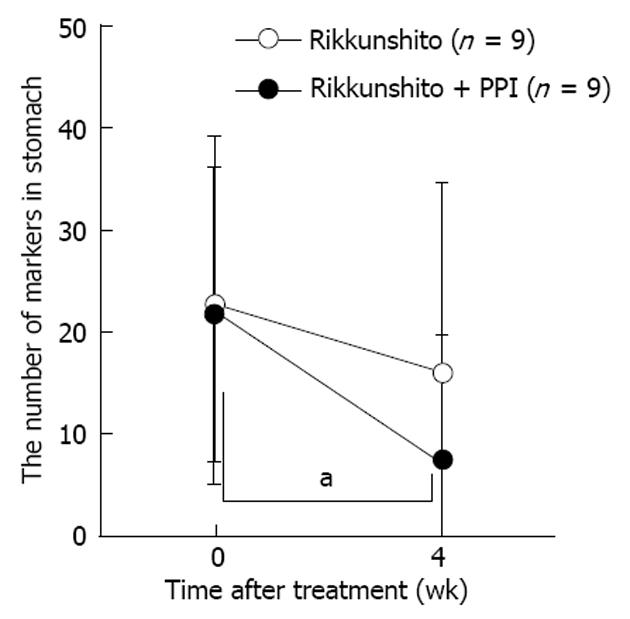Copyright
©2013 Baishideng Publishing Group Co.
World J Gastroenterol. Aug 21, 2013; 19(31): 5118-5124
Published online Aug 21, 2013. doi: 10.3748/wjg.v19.i31.5118
Published online Aug 21, 2013. doi: 10.3748/wjg.v19.i31.5118
Figure 1 Effects of proton-pump inhibitor monotherapy and subsequent treatment with rikkunshito alone or rikkunshito plus proton-pump inhibitor on visual analog scale scores for globus sensation in patients with proton-pump inhibitor-refractory laryngopharyngeal reflux.
Proton-pump inhibitor (PPI) monotherapy was delivered for at least 2 wk prior to the experiment. Each value represents the mean ± SD. aP < 0.05, significantly different from the visual analog scale (VAS) score at week 0 in each group (paired t test). No significant between-group differences were found at any time point.
Figure 2 Effects of rikkunshito alone and rikkunshito plus proton-pump inhibitor on gastric emptying in patients with proton-pump inhibitor-refractory laryngopharyngeal reflux.
Each value represents the mean ± SD. aP < 0.05, significantly different from the number of markers at week 0 in the rikkunshito + proton-pump inhibitor (PPI) group (Wilcoxon signed-rank test). We found no significant difference between treatment groups after the 4-wk treatment period (Wilcoxon rank-sum test).
Figure 3 Correlation between improvement in globus sensation and improvement in gastric emptying.
The improvement in globus sensation calculation based on pre- and post-treatment visual analog scale (VAS) scores using the following formula: Improvement (%) = [(pre-score) - (post-score)]/(post-score) × 100. Pre-score: VAS score before the start of rikkunshito or rikkunshito + proton-pump inhibitor treatment; Post-score: VAS score after the 4-wk treatment period. Improvement in gastric emptying was calculated based on the number of markers in the stomach before and after treatment.
- Citation: Tokashiki R, Okamoto I, Funato N, Suzuki M. Rikkunshito improves globus sensation in patients with proton-pump inhibitor-refractory laryngopharyngeal reflux. World J Gastroenterol 2013; 19(31): 5118-5124
- URL: https://www.wjgnet.com/1007-9327/full/v19/i31/5118.htm
- DOI: https://dx.doi.org/10.3748/wjg.v19.i31.5118











